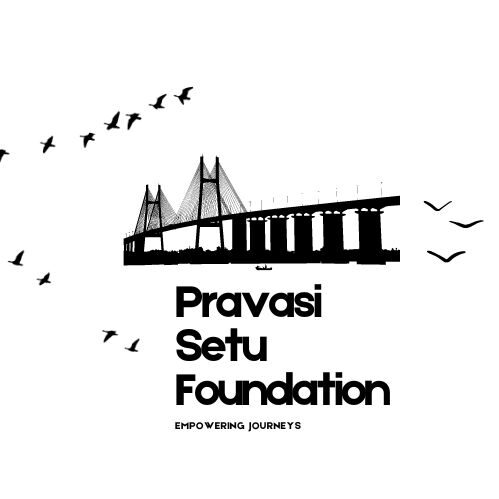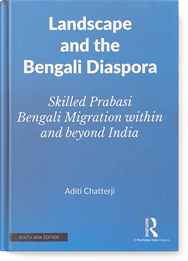Abstract
Bengali diasporic literature was created by Bengali writers who have migrated and settled all over the world. Through their writings, they express their complex experiences and cultural negotiations in living within new milieus while maintaining ties with heritage. Diasporic literature gives deep insight into the emotional and cultural journeys of the Bengali diaspora regarding questions of identity, belonging, migration, and displacement. Its journey goes back to the early 18th century when the first few rich Bengalis started travelling abroad as part of the Bengal Renaissance and documented their experiences and it started as the first diasporic accounts. This is carried through by contemporary writers like Bharati Mukherjee, Chitra Banerjee Divakaruni, Jhumpa Lahiri, and Amitav Ghosh, who bring an idea of harmony between cultural retention and assimilation. Their works underline women’s roles as preservers of cultural heritage and agents of adaptation. Their works are often imbued with themes of hybridism and transnationalism, which propagate the idea of modern identity being dynamic and intertwined. Intrusions of Bengali words and cultural references into English narratives are a powerful medium for the expression of hybridity within diasporic experience, offering intricate portrayals of what it means to live between worlds. Bengali diasporic literature contributes to the global literary scenario by celebrating resilience and richness as part of Bengali heritage in growing interconnectivity.
Introduction
Bengali diasporic literature encompasses works by Bengali authors who have migrated from their homeland and settled in different parts of the world. This category portrays the challenges, experiences, and cultural interactions that accompany living in a new place while still holding onto one’s cultural heritage. Diasporic literature in Bengali frequently acts as a powerful portrayal of existence and selfhood, providing a profound understanding of the diverse experiences of individuals and communities managing the challenges of living within different cultures. This body of literature provides profound insights into the emotional and cultural journeys of the Bengali Diaspora, touching upon themes of identity, belonging, and the continuous negotiation between the old and the new. A significant and concurrent body of literature in Indian languages is created by the Indian diaspora. Even though this corpus in Indian languages includes original and important contributions, it remains underexplored and does not receive sufficient attention. Recent developments in diaspora studies highlight the crucial role of language in constructing and negotiating Diaspora identities and relationships.
However, scholars in linguistics and literature-related fields have not examined these connections as extensively as their counterparts in the social sciences. 44 Writers from the Indian Diaspora have primarily contributed to literature in English, and their works have attracted a wide range of readers. Readers of contemporary post-colonial fiction are now thoroughly conversant with the themes of migration, homelessness, exile, loss of identity and rootlessness which form the staple diet of much Third World, post-colonial and commonwealth writing. Diasporic fiction writers of Indian origin in the last two decades of the twentieth century have had amazing success and emerged as a clear sub-set of writing in English from the Indian state of Bengal, from the country of Bangladesh, and known as ‘Probashi Bangalis’. Some obvious relatively recent names in fiction include Bharati Mukherjee, Amitav Ghosh, Upamanyu Chatterjee, Nalinaksha Bhattacharya, Adib Khan, Amit Chaudhuri, Chitra Banerjee Divakaruni, Ruchira Mukherjee, and Jhumpa Lahiri. Lorem ipsum dolor sit amet, consectetur adipiscing elit, sed do eiusmod tempor incididunt ut labore et dolore magna aliqua. Ut enim ad minim veniam, quis nostrud exercitation ullamco laboris nisi ut aliquip ex ea commodo consequat.
Historical Context and Emergence:
Since the early 18th century, affluent Bengali men have been journeying overseas. The Bengal Renaissance spurred many upper-class Bengalis to embark on dangerous voyages across the seas. Raja Rammohan Roy, Dwarkanath Tagore, Debendranath Tagore, Michael Madhusudan Dutt, Sayyed Ameer Ali, Satyendranath Tagore, Satyendraprasanna Sinha, Rabindranath Tagore, and many others were sent by their families to England to study law, medicine, or prepare for the Civil Services Exam. They chronicled their experiences abroad and documented their lives as Probashi. These writings are considered the first diasporic accounts in Bengali. Rabindranath Tagore’s Europe ‘Prabashir Patra’ first published in the magazine Bharati as letters and then in 1881 as a book, provides a detailed account of English social life in the latter half of the 19th century. The first diasporic Bengali text written by a woman was a travel book published in 1885 by Krishnabhabini Das. She had accompanied her husband Debendranath Das to England in 1882 and stayed for eight years, closely observing Victorian society and later compiling her experiences in the volume ‘Inglonde Bangamahila’ published in 1885. The migration of Bengalis from West Bengal and present-day Bangladesh has continued without interruption.
Today, the Bengali diaspora is spread across numerous countries and continents. This diaspora is varied in terms of class, caste, and culture. Some notable present day diasporic writers who write in Bengali are widely read in West Bengal and Bangladesh hail from the United Kingdom and the United States. Prominent among them are Ghulam Murshid and Abdul Gaffar Choudhury from the UK, as well as Dilara Hashem and Alolika Mukhopadhyay from the USA. Ketaki Kushari Dyson, a prominent writer from the Bengali diaspora who writes in Bangla, is known for her diasporic sensibility. She is a versatile artist, excelling in poetry, criticism, essays, plays, columns, novels, and translations. Her debut novel, “Noton Noton Pairaguli” (1983), draws inspiration from the letters and diaries of a Bengali woman living in Britain. Other notable works include “Rabindranath O Victoria Ocampor Sandhaney” (1985), exploring Rabindranath Tagore’s connection with Argentine writer Victoria Ocampo. “Jal Phunre Aagun” explores the perspectives of a Bengali man of mixed heritage and his multi-racial daughter. Then “Tisidore” talks about the worlds of Jibanananda Das and Buddhadeva Bose.
Dyson’s writings highlight the cultural interconnectedness and transculturation within the Bengali diaspora. Her essays, such as ‘Bangla Sahityer Diasporik Bhuban’ and ‘Deshaar Bidesh: Bangla Diasporar Kayekjon Sahityik,’ further explore themes of emigration, cultural mediation, citizenship, and transnationalism in Bengali literature. Bangla diasporic literature is increasingly attracting significant critical attention. In addition to the works of established authors, publications such as the magazine Agrobeej and the bilingual Bangla Journal from Toronto, among others from various parts of the world, serve as important outlets for contemporary diasporic creative expression. Much of this writing represents the middle-class professional diaspora and frequently explores the complexities of navigating between two worlds, as well as the multiple connections within a transnational community.
Themes of Migration and Displacement
Different Diasporic Narratives centre on the mental and physical travels associated with migration and highlight the challenges and rewards of beginning in a strange country. In Bharati Mukherjee’s “Jasmine” the protagonist’s journey from India to the United States involves multiple transformations as she adapts to different cultural contexts. Jasmine’s ability to reinvent herself in response to her changing circumstances highlights the fluidity and resilience required of migrants. Her story underscores the idea that migration is not a single event but an ongoing process of adaptation and redefinition. Her first novel, “The Tiger’s Daughter” (1972) draws heavily on her upbringing in an upper-middle-class Bengali family in Calcutta. The protagonist, Tara Banerjee Cartwright, is an Indian woman married to an American, who returns to Calcutta and finds herself disconnected from the city of her birth. When Tara returns to Calcutta, she encounters a city vastly different from her memories. Not yet fully integrated into American culture, she feels estranged from her native land’s values and morals. The novel concludes with Tara recognizing that her marriage and life in America have permanently separated her from her roots in Calcutta. Mukherjee captures the intense nostalgia for the sensory experiences of one’s childhood homeland. Mukherjee’s personal experiences further inform her work, as seen in “Days and Nights in Calcutta” (1977), co-written with her husband, Clark Blaise. Here, she reflects on her homeland from an exile’s perspective, but by the end, she identifies more as an immigrant than an exile.
Women in Bengali Diasporic Literature
Diasporic literature serves as the custodian of cultural heritage and the primary agent of adaptation and resilience. Bharati Mukherjee’s second novel, Wife (1975) explores the psychological struggles of Dimple Dasgupta, a young woman from Calcutta’s middle class, who moves to New York with her husband and ultimately murders him out of frustration. Dimple’s inability to adapt to her new life highlights the hollowness of traditional Bengali marriage expectations and the challenges of cultural transition. Bharati Mukherjee’s later works, like “Leave It to Me” (1997) continue to explore themes of cultural identity. The protagonist, Debby Di Martino, transforms into Devi, drawing on the mythology of the goddess Durga. This cultural specificity underscores Bengali heritage. Her novels such as “Desirable Daughters” and its sequel “The Tree Bride” remain deeply rooted in her Bengali background. In these works, she juxtaposes the experiences of modern-day and historical Bengali women, reflecting on the complexities of cultural identity and the enduring connection to her birthplace. She has often spoken about the need for creative individuals to sever ties with their roots to thrive in a new environment, yet her writing reveals a persistent connection to her Bengali heritage.
Her portrayal of Calcutta and Bengal in her fiction demonstrates that, while changing citizenships may be straightforward, swapping cultures is not. Through her novels she continues to engage with her Bengali identity, making her both an American and a Bengali writer. Chitra Banerjee Divakaruni, born in Calcutta, moved to the U.S. at nineteen to pursue higher education. Her first short story collection, “Arranged Marriage” (1997) examines cross-cultural experiences of womanhood from a feminist viewpoint, focusing on Indian immigrants in the U.S. The stories highlight the challenges faced by women navigating traditional Indian values and newfound American independence. Her first novel “The Mistress of Spices” blends prose and poetry with magical realism, drawing on Bengali folklore. “Sister of My Heart” (1999) written in a realist style, explores family relationships in Bengal, presenting a multi-layered narrative. Her collection “The Unknown Errors of Our Lives” (2001) and the novel “The Vine of Desire” (2002) further explore the immigrant experience, juxtaposing Indian and American cultures. Divakaruni’s work reflects her Bengali upbringing and the complexities of cultural identity. She evolves her writing style, moving from detailed glossaries to seamlessly integrating Bengali terms, enhancing the exoticism of her narratives.
Contribution to the Postcolonial Indian English Fiction
Fiction, culture, and history are deeply intertwined. Culture is essentially the product of ongoing dialectical historical processes, and fiction engages with issues of cultural identity. While Western fiction often centres on the individual’s life, fiction from the Indian subcontinent places greater emphasis on the life of the family or community, with personal identity merging into the cultural identity of the community. Historically, it is undeniable that post-coloniality is an unavoidable condition influencing the entire range of fiction produced by Indian writers, including those in the diaspora. The depiction of Indian immigrants in the fiction of diasporic female Indian writers is considered to be more nuanced and sensitive. 1469 Writers can engage readers of Indian English literature with a compassionate and straightforward style while conveying the universal experience of immigrants on behalf of Indian immigrants. Additionally, the Bengali-English fiction of the diaspora keeps its writers connected to both India and the broader world. The writers of the Indian diaspora are the active participants in the reconstruction of Western and Eastern perspectives by focusing on ethnic, cultural, communal, and political conflicts.
The central preoccupations of the diasporic writers are the themes of displacement, dislocation, exile, native identity and myths, journey as a metaphor, and migration and experiences of immigrants. Drawing from Rushdie’s idea of the Empire writing back to the center, the Indian diaspora writes back to the Indian center. The location of the author gives authenticity to the representation of cultural identity. Jhumpa Lahiri’s celebrated debut novel, “The Namesake” explores the complexities of the Indian other in the U.S. Bharati Mukherjee’s “Desirable Daughters” shows how the sense of nostalgia for the motherland churns out and attachment to the native country leading to an unsettled quest for a fluid identity. Writings acknowledge the presentation of a hybrid space of the contemporary metropolis. These writers have registered a global presence yet their works are rooted in diverse cultures competing for their survival.
The Concept of Identity and Belonging
Bengali diasporic literatures help to explore the identity and profoundly examined the tension between cultural retention and assimilation. These literatures offer a nuanced portrayal of immigrants who straddle the line between their parents’ heritage and their own experiences in the Western world. Writings highlight the tension between maintaining Bengali cultural identity and assimilating into the culture of the host country. Jhumpa Lahiri, a second-generation writer living in the United States, infuses her work with Indian, especially Bengali, culture. Although she finds it hard to identify as American, her stories explore Bengaliness and immigrant experiences. Her characters often navigate dual cultural identities, seamlessly shifting between them.
Her stories in “Interpreter of Maladies” (1999) depict the struggles of displaced individuals and emphasize Bengali culture through detailed descriptions of names, food, and customs. Lahiri’s stories, set in both America and India, reflect themes of exclusion, loneliness, and the search for fulfillment. For instance, “The Treatment of Bibi Haldar” and “A Real Durwan” highlight Bengali customs and superstitions. In stories like “A Temporary Matter” and “When Mr. Pirzada Came to Dine,” she illustrates the immigrant experience and cultural nuances. “Mrs. Sen’s” is particularly rich in Bengali details, from cooking methods to language use. Her characters, often Bengali, grapple with cultural disorientation and identity. Despite her deep connection to Calcutta, Lahiri emphasizes the city’s role in her imagination rather than a literal home. She acknowledges her unique perspective as neither a tourist nor a resident, allowing her to observe and belong simultaneously. Lahiri’s work resonates with universal themes of alienation while retaining a distinct Bengali essence, reflecting her nuanced understanding of cultural identity.
Hybridity and Transnationalism
Concept like hybridity and transnationalism reflected in Bengali diasporic writings and through this one finds the dynamic and interwoven character of modern identities. It is in the ways that diasporic people and societies combine aspects of several cultures to form new hybrid identities and merging of characters balance at a time with incompatible expectations of new cultural background. Amitav Ghosh’s “The Glass Palace” and “Sea of Poppies” represent the multivalent nature of Bengali identity. The interwoven histories of colonialism, migration, and globalization are reflected in his characters’ cross-cultural and cross geographic travels. The stories that Ghosh brings out are those of elasticity in identity and ways by which people from the diaspora negotiate life in a global society. The language, along with the narrative techniques that diaspora writers use, is also hybrid. Many authors, in an attempt to weave a tapestry of language reflecting dual heritage, use Bengali words, phrases, and cultural allusions within English writing. This literary representation of mixed identity of diasporic people with the use of multiple languages helps to capture hybridity in cultural experiences.
Conclusion
The intricate interplay of cultural heritage, migration, and identity is reflected in the rich multi-layered Bengali diasporic literature. These works come to function as custodians of tradition while being the very first agents in adaptation, resilience, and varied experiences of immigrants who straddle between the heritage of their ancestors and the demands of newer environs. Influential writers like Bharati Mukherjee, Chitra Banerjee Divakaruni, and Jhumpa Lahiri focus on thematic content, which addresses cultural maintenance and assimilation, revealing how difficult and wonderfully success it could be for a character to struggle with hybrid identity creation. We see Bharati Mukherjee from her personal experience as an immigrant has presented the psychological and cultural transitions of her protagonists. Correspondingly, Chitra Divakaruni’s stories depict the cross-cultural experiences of Indian women by combining Bengali folk tales with present feminist sentiments and portray the turmoil that women face in crossing worlds.
Jhumpa Lahiri portrays the Bengali customs and immigrant life with the alienation and belonging themes. Her characters recurrently balance twin identities against the fluidity of cultural assimilation. Amitav Ghosh has used epic narratives to examine historical and global dimensions of Bengali identity those vast stories about colonialism, migration, and globalization. Diasporic literatures shift in languages and narrative techniques and incorporate Bengali words with cultural reference into English writing and thus represent the hybridity of the identities. In this sense, these literary works present a subtle representation of the immigrant experience but celebrate the dynamic and intertwined character of modern identities.
In other words, Bengali diasporic literature extends to intricate levels concerning issues of identity, migration, and cultural hybridity. It represents spirit of living between worlds that describes a condition full of problems but at the same time underlines the resilience of the diasporic community. These authors gave to the literature their sensitivity about the complexities of cultural identity in the face of rising interconnectivity across the world. They are making genuine contributions to world literature while holding the richness of Bengali heritage.
Bibliography
Telugu, Sireesha. “Introduction” In Indian Literatures in Diaspora. Edited by Sireesha Telugu. United Kingdom: Taylor & Francis, 2022.
Mandal, Somdatta. “Oh Calcutta ! The New Bengal Movement in Diasporic Indian English Fiction,” Indian Diaspora-The 21st Century Anthropologist Special Issue. 2. (2007). 9-21.
Pandurang, Mala. “Indian Languages and Literature in the Diaspora: An Overview,” In Sociology of the Indian Diaspora. Edited by Kamla Ganesh. Gujarat: Inflibnet Centre pub, July 24, 2018.
Kumar, Dr. Pradeep. “Indian English Fiction: Postcolonialism and Beyond.” IJCRT. Volume 11, 4, April (2023), 893-97.
Babar Shaikh, Azeem Shaikh., , Shekhawat, Dr Anupama. “A Study on the Diaspora in Indian English Literature,” Journal of Critical Reviews, Vol 7, 2, (2020), 1466-77.



Leave a Reply